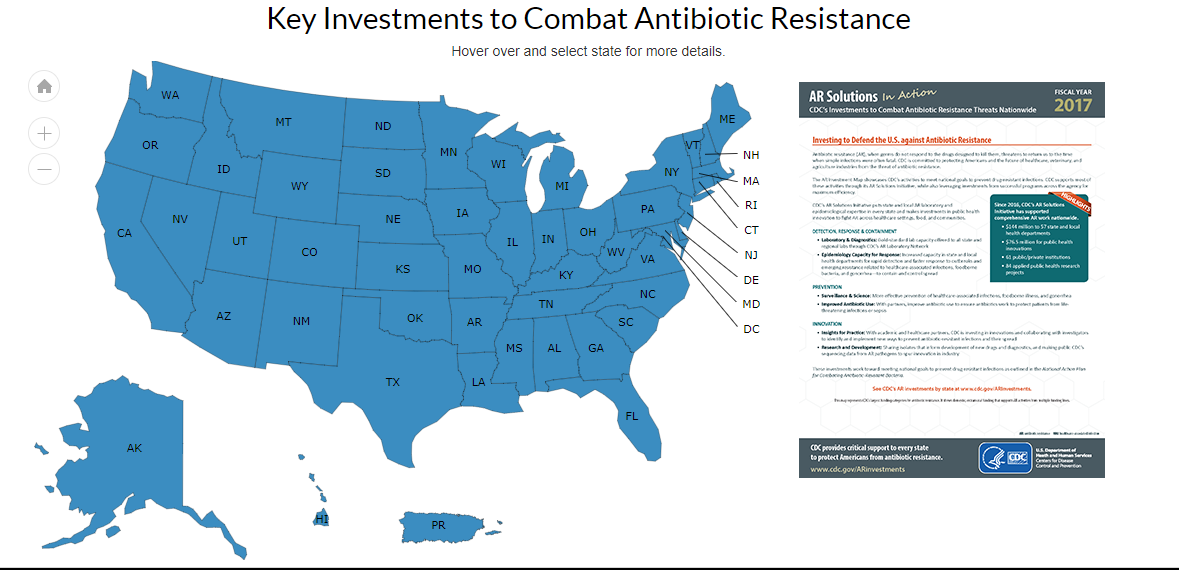
Click for interactive features of the CDC's AR map.
The Centers for Disease Control and Prevention (CDC) released in January new data in its Antibiotic Resistance (AR) Investment Map, which shows early progress by states to combat AR. This year’s AR Investment Map features more than 170 state-reported successes—like rapidly identifying and containing rare and concerning resistant germs to protect communities. Each state reported multiple successes. These are the first comprehensive reports on state progress made following the first year of Congress’ unprecedented investment in CDC’s Antibiotic Resistance Solutions Initiative.
The AR Investment Map displays CDC’s AR activities in printable state- and city-specific fact sheets, providing a comprehensive view of CDC’s resources to protect Americans from antibiotic-resistant infections. Antibiotic resistance occurs when germs no longer respond to the drugs designed to kill them. Some germs already have become resistant to all available antibiotics, making some completely untreatable.
“Antibiotic resistance has the potential to impact all Americans at every stage of life,” said CDC Director Brenda Fitzgerald, M.D. “This interactive map showcases the work happening on the frontlines of every state and CDC’s commitment to keep people safe from drug-resistant infections.”
In fiscal year 2016, CDC made investments in all 50 states, six large cities, and Puerto Rico to enhance laboratory and epidemiology expertise and grow public health innovations to fight antibiotic resistance across healthcare settings, food, and communities.
These investments helped states like Oklahoma and Connecticut each successfully identify and contain a single case of Candida auris, a multidrug-resistant fungus that can cause deadly infections.
Early progress shows antibiotic resistance investments are working
Also displayed in the new AR Investment Map are successes states reported for fiscal year 2017:
- In Tennessee, when a person got a rare and concerning infection, the state health department and facility immediately began CDC’s containment protocol and isolated the patient. Within 48 hours, the teams fully executed the containment protocol (AR Lab Network testing, infection control assessments, colonization screening). Since then, the facility has not identified additional cases.
- Michigan reduced “nightmare bacteria” CRE by 30 percent in 40 facilities and prevented more than 300 infections through its surveillance and prevention initiative.
- Thirty-eight states and two cities now use whole genome sequencing to monitor for outbreaks and identify antibiotic resistance for Listeria, Salmonella, Campylobacter, and E. coli that are commonly transmitted through food and animal contact. When these outbreaks are detected, local CDC-supported epidemiologists investigate the cases to stop the outbreaks and spread of resistance. Since the end of fiscal year 2017, six more health departments successfully implemented whole genome sequencing.
- In Kentucky, an aggressive and coordinated response to a rare and concerning resistance gene successfully contained the outbreak and stopped its spread.
- California increased its local response capacity to combat resistant gonorrhea and increased its rapid susceptibility testing by eight-fold. Susceptibility testing shows how well a gonorrhea strain will respond to specific antibiotics. These results are used to inform local outbreak response action, national treatment guidelines, and antibiotic resistance trends.
In its mission to protect people, a significant portion of CDC’s AR investments goes to enhancing infrastructure in health departments nationwide. Since 2016, CDC has provided $144 million to 56 state and local health departments and Puerto Rico to address this threat. CDC has also invested more than $76 million in more than 60 universities and healthcare partners to find and implement innovative ways to prevent resistant infections and contain their spread.
The updated AR Investment Map reflects fiscal year 2017 extramural funding and highlights CDC’s collaborations that protect people worldwide. CDC continues to partner with health departments; academia; and the healthcare, veterinary, and agriculture industries to advance the science and implement strategies that protect Americans from antibiotic resistance.
Learn more about CDC’s AR Solutions Initiative and ongoing work to combat AR at www.cdc.gov/DrugResistance.

